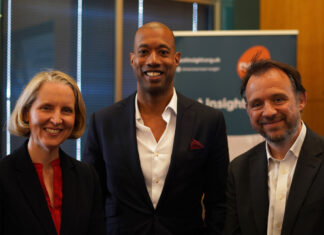The challenge
Imagine a climber attempting to scale a mountain. As they grip the rock face, their upward progress is hindered by a challenge: they struggle to find or maintain a firm footing to support their next move. This is what it can feel like for those on low- and moderate-incomes trying to build their financial resilience.
There is strong evidence that even a modest amount of accessible savings can meaningfully protect people from financial harms and improve financial health on a range of measures. People want to save, but many struggle to do so.
In the absence of savings, what options do people have for their financial ‘climbs’, when they need affordable access to money to bridge a gap, manage an unexpected expense, access opportunities or reach life milestones? We know that many people lack savings, and that many of those who do have savings have had to use them to cope with cost-of-living challenges in recent months.
Our research
With support from JPMorgan Chase we recently completed an exploratory piece of qualitative research that aimed to answer the question of what employers can do to support their employees’ financial wellbeing beyond emergency savings solutions. We focused specifically on earned wage access (EWA) and workplace loan models, and how these compare with other workplace financial wellbeing interventions. We were also interested in how employers, providers and employees view these options in a climate of rising financial precarity and anxiety.
We started by looking at what we know about the needs of people on low- and moderate- incomes, the gaps they experience in their present and future financial wellbeing, and consequently what entry points there are for employers to bridge those gaps.
Moving to an enabling framing
In our research, we found that much of the discussion of those needs is fairly prescriptive; it’s about what workers need to do. Their needs get framed in terms like, “They need to save more”, “They need to spend less” or “They need to avoid costly debt.” These aren’t strictly inaccurate, in the sense that having more control over household expenditure and remaining free from problem debt could reasonably be part of a financial wellbeing health check. However, when we spoke to workers themselves, they didn’t frame their needs in these terms. Instead, they talked about the common financial pinch points that test their resilience in the present and make their aspirations for their financial futures feel harder to reach. So, we have suggested a slight reframing, away from a prescriptive view—”They need to do something”—and to an enabling framing.
From there, we developed a framework that we are calling the six financial footings. These footings capture the financial needs of low- and moderate-income workers, all of which have clear entry points for employer-driven solutions. They aren’t unique to low- and moderate-income workers, but like our climber, it can be harder for them to obtain and maintain them. We’ve categorised them into needs that support resilience in the short term, and those that are focussed on planning for future financial wellbeing.
The six financial footings
| Improving financial resilience today | |
| Escaping the poverty premium | Low- and moderate-income workers need affordable, accessible alternatives to high-cost credit, higher insurance premiums and more expensive travel. They often aren’t able to pay large, upfront costs, like a cheaper rate on an annual premium compared with monthly charges, or higher prices for last-minute bookings. They need options that don’t cost them more over the long term because they can’t pay a big lump sum. |
| Managing unpredictable and seasonal income | Where income is inconsistent or unpredictable, it can be difficult to manage money around the ups and downs and to cope with costs in leaner months. Some low- and moderate-income workers need tools that empower them to smooth their cashflow and help to reduce the stress and anxiety of variable income. |
| Reacting to financial shocks | Unexpected costs and abrupt changes in life circumstances can test low- and moderate-income workers’ financial resilience to a breaking point. Many don’t have a savings buffer or access to affordable credit to handle financial shocks, including emergency costs and those that may come with big life changes, such as illness, bereavement or having to enter the private rental market or move house at short notice. |
| Planning for financial needs in the future | |
| Budgeting for smaller events that can be planned for | Some life events have less financial impact but nonetheless require planning – including budgeting that may be challenging to workers on low or variable pay, and for which personal loans may not be a good or available option. Such events could include holidays, uniform and other costs at the start of the school year or the purchase of a major household item. |
| Building resource for milestone events | Major life events have significant financial impacts, even when they’re planned for and predictable. These financial needs include adding a child to the family or making a planned house move or purchase, for example. |
| Progressing financially | Low- and moderate-income workers want to be able to set and reach a variety of financial goals, including building short- and long-term savings, managing their debt and building assets, in order to be able to progress financially and work towards bigger goals. |
A useful framework
We’re aware that there are many frameworks for assessing need and segmenting populations of workers. We think this framework is useful because, firstly, it acknowledges the fact that those on low- and moderate-incomes are making financial decisions with numerous constraints, and often do not have the options available to higher earners, and secondly, it therefore points usefully to opportunities for employers.
Through the financial footings, we see an opportunity to reconsider the role of employers in improving employees’ financial resilience. By slightly reframing workers’ needs, we also have a framework for assessing how effective different employer-driven initiatives are in supporting employees’ needs and ambitions. For example, we found in our study that some of the ways EWA and workplace loans influence people’s financial footings might be expected, while others may be counterintuitive:
- EWA may be best suited to address immediate, short-term needs, but we also considered its potential for promoting long-term financial wellbeing and progression by giving employees with multiple sources of income a tool for deciding how to use those different sources, including prioritising certain income sources for long-term financial goals.
- Deposit loans, although we think of them as meeting an upfront cost today, can play a role in long-term financial progress. A great example of this is when a childcare deposit loan supports women to return to the workplace, or where they facilitate a move to a better paid job.
| Our research highlights the complex perspectives between low- and moderate-income earners and those who employ them. We think the financial footings could be a way to bridge employees’ experiences of financial hardship and employers’ business and operational considerations, and find solutions for people who might most benefit from them. | “As an organisation we were historically quite paternalistic. We’re pivoting from that into creating an environment so that employees can use the tools and services that are right for them. There’s not one silver bullet or way to communicate. We want to allow people to make the right decisions for them.” Employer |
If you’d like to find out more about our research, you can read our report: Bridging financial gaps for workers (PDF) or contact us: insight@nestcorporation.org.uk
Sope Otulana, Head of Research at Nest Insight







